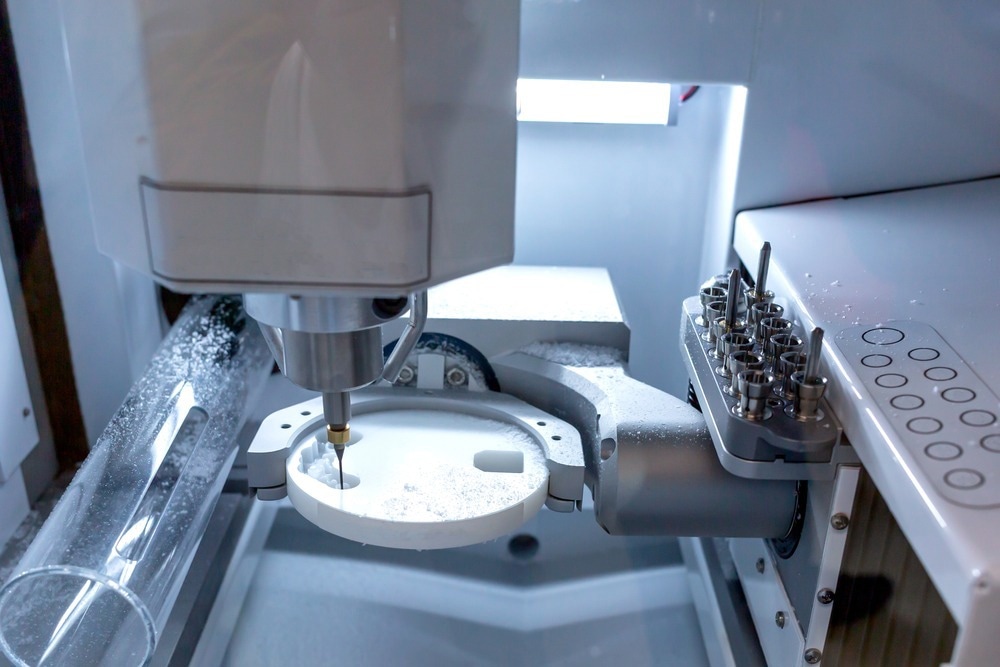Ceramics have evolved significantly from their traditional use in pottery to become essential materials in various industries. Advanced ceramics, with their unique properties, are now integral to electronics, aerospace, energy generation, and other industrial sectors.

Image Credit: ANDRIY B/Shutterstock.com
Evolution and Classification of Advanced Ceramics
Historically, traditional ceramics like porcelain, brick, and earthenware were primarily composed of clays and silicates and were used by early civilizations to create functional objects. Over time, enhancements in strength, thermal resistance, and electrical properties expanded their applications.
Modern advanced ceramics are precisely engineered to possess superior and specific properties tailored to various applications. These advanced ceramics are classified into oxides, non-oxides, and composites.1, 2
Oxides form the largest group, comprising ceramics based on metal oxides like alumina (Al2O3), zirconia (ZrO2), and titania (TiO2), known for their exceptional high-temperature stability, chemical resistance, and wear resistance.
In contrast, non-oxide ceramics like silicon carbide (SiC), boron nitride (BN), and silicon nitride (Si3N4) do not contain oxygen but offer superior mechanical properties like high strength and hardness, making them ideal for wear applications and high-temperature environments.2, 3
Composites combine different materials to create new properties. For instance, ceramic-matrix composites (CMCs) embed ceramic fibers within a ceramic matrix to improve fracture toughness and mechanical strength.4 They are also used in gas turbine engines and high-performance cutting tools.
Properties and Production of Advanced Ceramics
Advanced ceramics have distinct properties that set them apart from traditional ceramics and metals. They have high abrasion resistance and significantly outperform metals in wear resistance, making them ideal for applications like grinding media and cutting tools.
Their resistance to chemical degradation allows them to withstand harsh environments and corrosive chemicals. Their hardness enables machining at high speeds, improving production efficiency.
The production of advanced ceramics involves a multi-stage process requiring meticulous control. Oxide ceramics typically use powder-based, high-purity starting materials formed using techniques like pressing, slip casting, or injection molding. The formed components then undergo firing, a critical process where they are exposed to high temperatures for densification and enhanced properties.5
Non-oxide ceramics, on the other hand, often require specialized processing techniques due to their high reactivity at elevated temperatures. Their production involves preparing starting powders, mixing to create compounds, and forming and sintering the final component. Techniques like hot pressing or chemical vapor infiltration (CVI) achieve the desired microstructure and properties.
Ceramic-based composites can consist of various combinations, such as oxide and non-oxide ceramics, ceramics and metals, or ceramics and polymers, complicating the fabrication processes.
Ceramic matrix composites are fabricated using various methods based on material requirements and applications. The choice of processing technique depends on factors like the type of reinforcement, operating temperature, geometry, and composite size.
Common fabrication methods for solid-phase processes include slip casting and powder metallurgy. In liquid-phase processes, polymer infiltration pyrolysis and sol-gel techniques are commonly employed. For gas-phase processes, chemical vapor infiltration, chemical vapor deposition, and reaction bonding are frequently used.6
Firing and Finishing Techniques
Firing, or sintering, is a critical step in advanced ceramics production, influencing their final properties. Various firing processes, including gas heating, resistance heating, and inductance heating, are necessary for advanced ceramics.
Gas heating, used for large-scale production, provides uniform temperature distribution at normal to low pressures. Resistance heating offers precise temperature control, essential for high-purity ceramics, and operates at pressures ranging from vacuum to 200 MPa. Similarly, inductance heating is used for materials requiring rapid heating and cooling cycles.
The hardness of advanced ceramics presents challenges in finishing, necessitating specialized techniques like laser cutting, water jet cutting, diamond grinding, and electrical discharge machining (EDM).
Advancements in finishing techniques, such as additive manufacturing (3D printing), improved CNC machines, and new sintering methods like Spark Plasma Sintering (SPS), are enhancing the capabilities and applications of advanced ceramics.
3D Printed Ceramics
In a 2022 study, researchers demonstrated an indirect 3D printing approach for ceramics, combining Fused Deposition Modeling (FDM) with a replica technique to create complex, near-net-shaped Si-based non-oxide ceramic structures.
The process involved printing polylactic acid honeycomb lattices, which were then dip-coated with preceramic polymers and converted into SiCN and SiC ceramics through pyrolysis.7
This method retained the porous structure of the printed materials after high-temperature treatment, offering a cost-effective and straightforward way to produce customizable, lightweight, and highly stable ceramic architectures for various advanced applications.7
Future Outlook
Ceramics will play an important role in various industrial sectors in the future. Researchers are working to achieve higher bond energy and improved ductility, which will further expand their applicability in areas like structural components and high-performance turbines.
Advanced ceramics are being explored for applications in energy storage devices and lightweight armor. As industries seek materials that can withstand extreme conditions and deliver superior performance, advanced ceramics will play a crucial role in shaping the future of technology.
More from AZoM: What is Thermal Runaway?
References and Further Reading
- Hammel, EC., Ighodaro, OR., Okoli, OI. (2014). Processing and properties of advanced porous ceramics: An application based review. Ceramics International. doi.org/10.1016/j.ceramint.2014.06.095
- Otitoju, TA., Okoye, PU., Chen, G., Li, Y., Okoye, MO., Li, S. (2020). Advanced ceramic components: Materials, fabrication, and applications. Journal of industrial and engineering chemistry. doi.org/10.1016/j.jiec.2020.02.002
- Rainforth, WM. (2004). The wear behaviour of oxide ceramics-A Review. Journal of materials science. doi.org/10.1023/B:JMSC.0000045601.49480.79
- Chawla, K. K. (2012). Ceramic matrix composites. Composite Materials: Science and Engineering. doi.org/10.1007/978-0-387-74365-3_7
- Do, T., Shin, C., Kwon, P., Yeom, J. (2016). Fully-enclosed ceramic micro-burners using fugitive phase and powder-based processing. Scientific Reports. doi.org/10.1038/srep31336
- Rayat, MS., Gill, SS., Singh, R., Sharma, L. (2017). Fabrication and machining of ceramic composites—A review on current scenario. Materials and Manufacturing Processes. doi.org/10.1080/10426914.2017.1279301
- El Chawich, et al. (2022). Design and manufacturing of Si-based non-oxide cellular ceramic structures through indirect 3D printing. Materials. doi.org/10.3390/ma15020471
Disclaimer: The views expressed here are those of the author expressed in their private capacity and do not necessarily represent the views of AZoM.com Limited T/A AZoNetwork the owner and operator of this website. This disclaimer forms part of the Terms and conditions of use of this website.